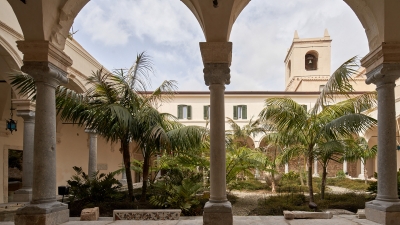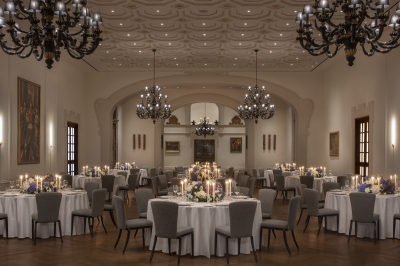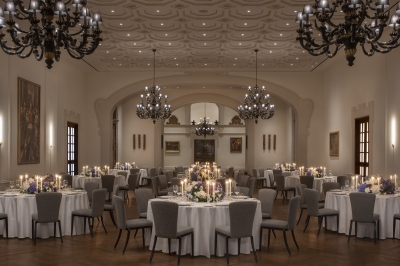In the heart of Taormina stands San Domenico Palace, A Four Seasons Hotel, whose rich past weaves a captivating tale. Once a Dominican monastery founded by the noble Damiano Rosso, the property has maintained its profound connection to art, architecture, and spirituality, preserving the essence of those who lived within its walls over the centuries.
The journey through the history of San Domenico Palace begins at the Great Cloister, a striking fusion of eras and styles. During three years of meticulous renovation, specialized restorers uncovered hidden details: Roman columns more than 2,000 years old and engravings that tell forgotten stories. One such inscription, attributed to a Dominican friar, likely the monastery’s architect, bears the name “Domingo Dvran Cathala 1718,” while another, presumably his assistant, remains indecipherable. These ancient columns, silent witnesses of stone, tell of the care and devotion the monks poured into this place, stories of spirituality and dedication. The Great Cloister was more than a space for reflection. It was also a hub of social life. The Dominicans, among the most refined orders in the ecclesiastical hierarchy, were famous for their opulent hospitality. It was often said that “for good food, you go to the Benedictines, but for luxury, you visit the Dominicans.” Today, this spirit lives on in the Hotel’s experience, where luxury and refinement are inextricably linked to a deep respect for the past.
Beyond hospitality, San Domenico Palace houses a collection of approximately 500 artworks, commissioned by monks from noble families. Many of these pieces can be found in the Sala Della Grande Madia, named for the antique cabinet where the monks once stored medicinal herbs grown in the gardens. This hall, once the monastery’s refectory, now serves as a gallery of treasures that narrate the palace’s rich history. The collection spans from religious paintings to depictions of daily life, such as Blind Man’s Bluff, from the Neapolitan, Roman, and Sicilian schools, dating from the 1500s to the 1800s. These artworks reflect the eclectic cultural interests of the monks, who embraced all forms of art and knowledge.
As you explore the property, you’ll encounter the family crest of Damiano Rosso: the comet. Founder of the monastery, Rosso introduced a deep religious tradition to Taormina, with a private chapel dedicated to Saint Agatha, the patron saint of Catania, his birthplace. This comet, carved in various parts of the property, can be found in the Ancient Cloister, on doorbells, and in the sacristy, symbolizing the Rosso family’s eternal presence in the monastery.
The Ancient Cloister is perhaps the most serene and contemplative part of the property. Designed by Damiano Rosso as a “Garden of Eden,” the cloister features a central jar, a symbol of life’s source, inspired by Arab influences. The palace’s gardens echo this sense of harmony. Divided into four distinct areas - the Citrus Garden, the Italian Garden, the Solarium and the Belvedere Garden - they form a perfect cross overlooking Taormina’s most iconic symbols: Mount Etna, the Ancient Theatre, the bay, and the town itself. This layout represents the four elements of nature - fire, earth, air and water - and reflects the balance between humans and their surroundings, reminiscent of Empedocles’ philosophy.
Just as the elements combine to create harmony, San Domenico Palace blends history and modernity into an experience that transcends time. A visit here is an immersion into living history, where every detail, every stone, and every artwork tells the story of a place that has preserved its soul, weaving together centuries of culture and tradition. At San Domenico Palace, the past is not a distant memory but a vibrant, tangible part of the present, continuing to inspire and enchant all who walk through its halls.














